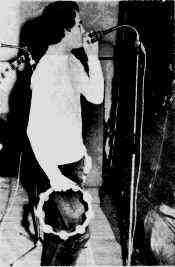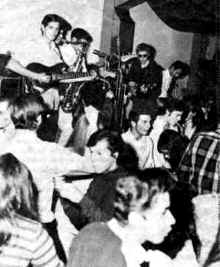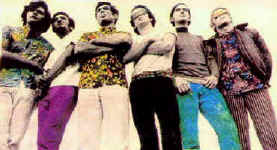 T R A F F I C S O U N D
T R A F F I C S O U N D 
 T R A F F I C S O U N D
T R A F F I C S O U N D 
It was mid 1964, when a group of young high school students,. Diego Garcia Sayan, brothers Freddy and Jose Rizo Patron, Ramon Orbegoso and Felipe Larrabure, formed the group Los Hang Ten's. The band had several additions, among them a promising vocalist, Manuel Sanguinetti.
In 1967, Jose and Freddy Rizo-Patron (lead and rhythm guitar), left Los Hang Ten's to join Manuel Sanguinetti, a lead singer and a former classmate, who wanted to form a more professional, tighter outfit. That group, with several key additions eventually became Traffic Sound, one of the most influential and creative groups that emerged from the rock 'n' roll scene in Peru in the 60's.
The new band had high hopes and the dream that one day they could play their music to larger audiences, perhaps even give rock concerts in the United States. After several months playing together and giving presentations to friends, they realized the only way to achieve their goals was to bring into the band other experienced rock musicians who shared their own particular high hopes.
The elected group of new musicians, among others, were the ex-members of Los Mads, perhaps
the first super-group in Peruvian psychedelic rock history. Manuel Sanguinetti
(lead vocals) called Jean
Pierre Magnet (sax and wind instruments) and Willy Thorne (keyboards); Willy got in touch with two
other friends, Willy
Barclay (bass) and Lucho Nevares (drums), who accepted to join the group and Traffic Sound was born.
The origin of the group’ s name was the traffic light, a souvenir from a wild night
in town, they found in the attic that was used for rehearsals, at the Rizo-Patron's
state.
After months of intense practice and presentations for friends, Traffic Sound started giving concerts at the Tiffany Club, the temple of Peruvian psychedelia. Because of their musicianship and popularity, a Peruvian label, MAG Records, gave them a recording contract in the last quarter of 1968. Their first single came out on the MAG label with the songs” Sky Pilot” and “Fire”, and it was followed by two others under the same label. The singles were cover songs by The Doors, Cream, Jimmy Hendrix and other groups that were Traffic Sound’ s main influences at the time. The covers were well executed, with an added Latin flavor, and with Manuel Sanguinetti singing in English. The singles sold out quickly and MAG decided to reissue all three of them as a compilation that became their first long-play : A Bailar Go Go (MAG LPN-2354) .
 |
 |
|
Manuel Sanguinetti (1968) |
Traffic Sound in Concert |
In 1969 they recorded their second LP, Virgin (MAG LPN-2382),
perhaps one of the finest rock albums made in South America in the seventies,
and regarded by many collectors among the best psychedelic LPs of all times. This time
all songs were original compositions, all group efforts, and played with
finesse, finally Traffic Sound had
developed its own style. Still some small influence from British rock is evident in some
compositions : “Virgin” (The Bee Gees) , “Tell the World I am Alive”
(Led Zeppelin) , “Yellow Sea Days” (Pink Floyd) and a touch of The Beatles’
“Strawberry Fields Forever” and “Sky Pilot” on their song
“A Place in Time Called You and Me ” (purposely presented backwards on
the LP).
Virgin made Traffic Sound the most popular group in Peru and the most requested
in concerts. Later on became the number one priority among serious collectors of
psychedelic recordings.
The first edition of the LP came out on the regular MAG package (front and back covers joined by a
rivet), the second edition was a fold out cover with pictures of the group (this
version of the cover is the most popular among collectors), the third and
last edition had a single cover, with the front and back glued together, and the record had an
orange label, instead of the original MAG black label.
In 1970 they recorded their third LP titled Traffic Sound (MAG LPN-2395);
in my opinion their finest album. This recording features eight tracks of highly original
material, full of “all out” improvised solos. At this point they had a strong,
mature sound; unique in the right mixture of psychedelic rock with Andean and Latin music.
The hit songs ”Chicama Way” and “Tibet’ s
Suzettes” revealed the group’ s inner thoughts and the atmosphere that
surrounded Peruvian youths in the early seventies.
The group got very active internationally in 1971. Not only they were
playing at the Tiffany and Galaxy Clubs, and all kind of private parties, but also went on
a tour paid by Braniff Airlines. The South American tour, the first one by a Peruvian rock
group, took them to Chile, Argentina and Brazil. They were welcomed everywhere as pioneers
of the new rock sound that was under formation in South America.
Right after the tour, the group decided to change to a different label, Sono Radio. During
the transition from MAG to their new label, Traffic Sound recorded 5 tracks, four of them
were released on two singles by both labels. The songs “La Camita” and
“Suavecito” were released by Sono Radio on an single with a picture
cover.
At the end of 1971 the group recorded their last album : Lux
(Sono Radio SE-9362).
This time the music was different from all the previous recordings. The Latin and Andean
influences were stronger, the songs picture a dim image of a country going through
difficult political and economic times. Songs like “White Deal” ,
“Inca Snow”, “The Revolution” , etc... tell us of a
Traffic Sound very much concerned with the future reality of Peru.
The flute and tenor sax of Jean Pierre Magnet are widely featured on this LP, as well as
the new member, Zulu, who replaced Willy Thorne on the electric bass and keyboards.
The release of this recording was troubled by labor union problems at Sono Radio that
caused the disappearance of the original master tapes until 1996, when
this writer found them labeled as “Andean folkloric music. “
Also in 1971, Traffic Sound gave its most memorable concert at the Teatro
Segura. They were accompanied by Jaime Delgado Aparicio, who also wrote the arrangements,
and the Contemporary Orchestra. The climax was the last song, “Mr. Skin”,
that lasted thirty minutes, with a delirious audience that did not want the music to stop.
By early 1972, most of the members of the group decided to follow non
musical careers, ending the activities of Traffic Sound. The only member that continued a
professional musical career was Jean Pierre Magnet. Today, Jean Pierre is an accomplished
musician, group leader and one of the best musical arrangers in Peru.
 |
|
|
| Traffic Sound (1969) | Traffic Sound on tour (1970) |
Traffic Sound got together one more time in 1993. The group gave a full house, moving concert, at the Club “El Muelle Uno,” in Lima. Their purpose was to expose the new generation of Peruvians to their music as well as a personal challenge to their abilities as musicians. This reunion produced a studio session where three of their original songs were recorded with new arrengements : “Meshkalina 2", “Chicama Way” and “Simple”. The last two songs are still unfinished. The concert was a success, but life had definitely changed for the members of Traffic Sound, they returned to their professional duties with sadness but with the satisfaction that they could still make good music. After all, they were Traffic Sound, one of the best if not the finest group ever to emerged from the South American rock scene in the seventies.
 Songs Lyrics from Traffic Sound
Songs Lyrics from Traffic SoundYESTERDAY' S GAMESee the Sun, It' s smiling in the skies |
TIBET' S SUZETTES
|
By George Bonilla Copyright ©1997 Lazarus Audio Products
Acknowledgments : thank you Willie Barclay for the priceless information and photos.